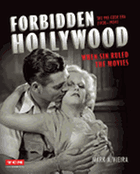
At first glance, film historian Mark A. Vieira's Forbidden Hollywood looks like a beautiful coffee-table art book filled with some never-before-seen vintage film stills. But on closer examination, it's revealed to be an illuminating, superbly researched treasure trove of Hollywood history and gossip.
In the late 1920s, the film industry created a production code to avoid local censorship in various U.S. communities. Many filmmakers ignored the code and accelerated the depiction of sexual innuendo, violence, prostitution, drug use, sexual infidelity and homosexuality. The industry finally clamped down on things in 1934, with the creation of the Production Code Administration that was enforced until 1968. Forbidden Hollywood profiles dozens of films created between 1930 and 1934 that broke through censorship guidelines--and were usually rewarded with huge audiences. In 1930's The Divorcee, Norma Shearer sleeps with her philandering husband's best friend and tells him, "From now on, you're the only man in the world my door is closed to!" In 1932, Howard Hughes produced Scarface with an incest subplot and a death toll of more than 40 people. In 1933's Search for Beauty, Ida Lupino uses binoculars to check out Buster Crabbe's bulging swimsuit and, later, a half-dozen naked men wander through a locker room. Other profiled films that ignited the stricter production code include She Done Him Wrong, Tarzan and His Mate, Frankenstein, The Sign of the Cross and Baby Face.
Forbidden Hollywood is a real treat for film buffs. The hundreds of photos are dazzling and evocative, and Vieira's history lessons are compelling and fresh. --Kevin Howell, independent reviewer and marketing consultant

